Key Takeaways
Discover how high schools use college signing walls to celebrate student-athlete commitments. Learn about traditional displays, digital solutions, and best practices for recognition programs.
What is a College Signing Wall?
A college signing wall is a dedicated recognition space within a high school that showcases student-athletes who have committed to compete in athletics at the collegiate level. These displays serve multiple purposes: honoring individual achievement, building school pride, inspiring younger athletes, and creating lasting tributes to athletic excellence.
The Significance of College Signing Recognition
When high schools prominently recognize college athletic commitments, the impact extends far beyond the individual athletes being honored. According to recent data, only about 7% of high school athletes go on to play sports in college, making these achievements particularly noteworthy and deserving of celebration.
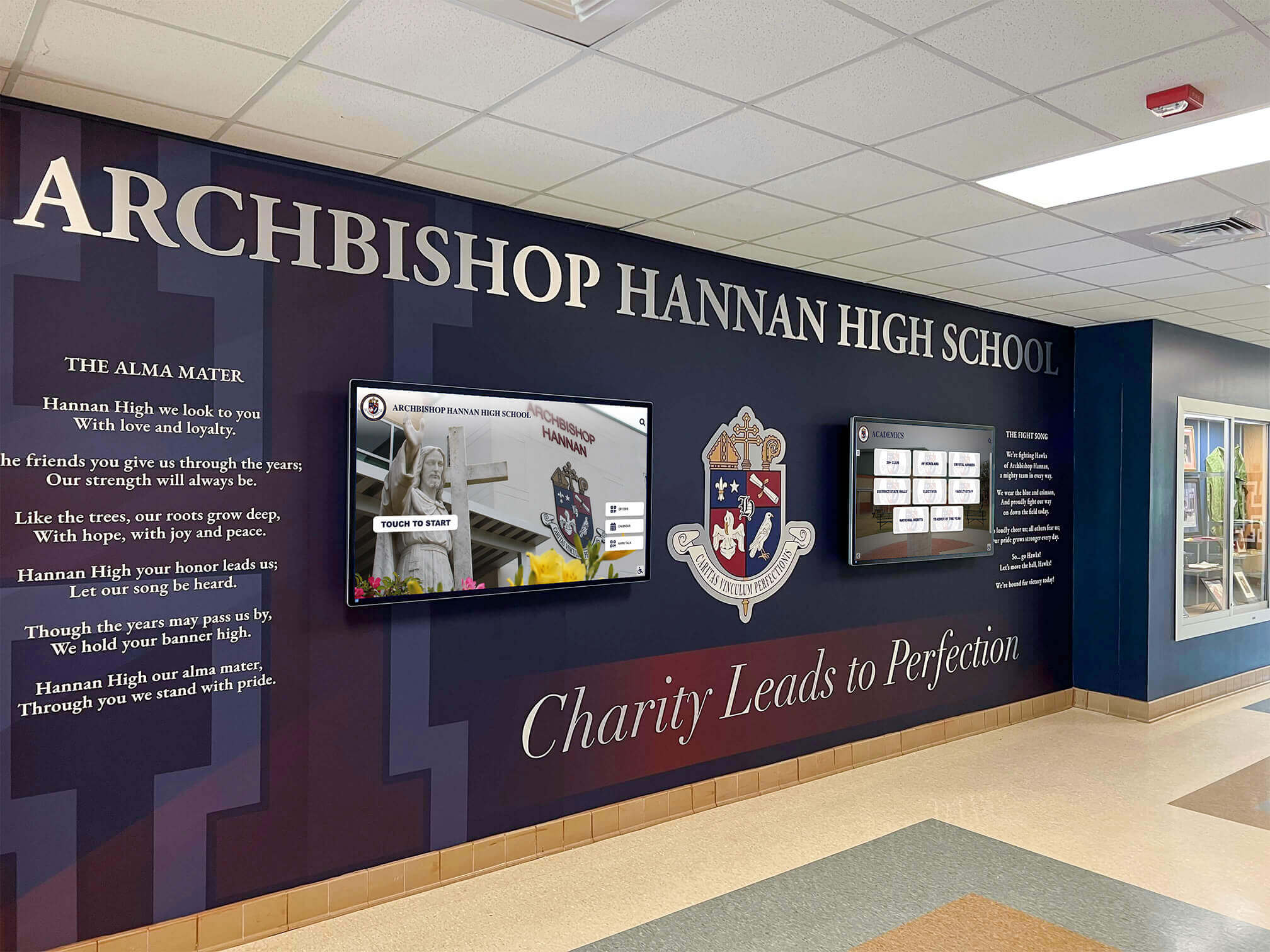
Recognition through signing walls provides several key benefits:
Inspiring Younger Athletes: When ninth and tenth graders see upperclassmen signing with college programs, collegiate athletics becomes a tangible goal rather than a distant dream. Visible success stories demonstrate that with dedication and hard work, playing college sports is achievable.
Building School Athletic Culture: College signing walls contribute to positive athletic culture by celebrating diverse achievements across all sports and competitive levels—from NCAA Division I programs to Division III schools, NAIA institutions, and junior colleges.
Strengthening Community Pride: Parents, teachers, coaches, and community members take pride in seeing local student-athletes achieve success at the next level. These displays become conversation starters and points of pride during campus visits.
Supporting Recruitment: For programs like college recruitment in athletic programs, visible signing recognition demonstrates the school’s track record of developing college-ready athletes, attracting ambitious young athletes to the program.
Traditional College Signing Wall Approaches
For decades, high schools have used various traditional methods to recognize college-bound student-athletes, each with distinct advantages and limitations.
Physical Wall Displays
Photo Boards and Plaques: Many schools create dedicated wall sections featuring individual photos of each signing athlete alongside plaques listing their name, sport, and destination college. These physical displays often line hallways near athletic facilities or main entrances.
Banner Displays: Some schools hang banners featuring athlete photos, college logos, and signing information. These eye-catching displays work particularly well in gymnasiums or athletic facilities where they remain visible during games and events.
Trophy Case Recognition: Traditional trophy cases can accommodate signing recognition alongside championship trophies and other athletic honors. This placement connects individual achievement with team success.
Bulletin Board Celebrations: Budget-friendly bulletin board displays allow schools to showcase signing day photos, commitment announcements, and athlete profiles using affordable materials that can be updated annually.
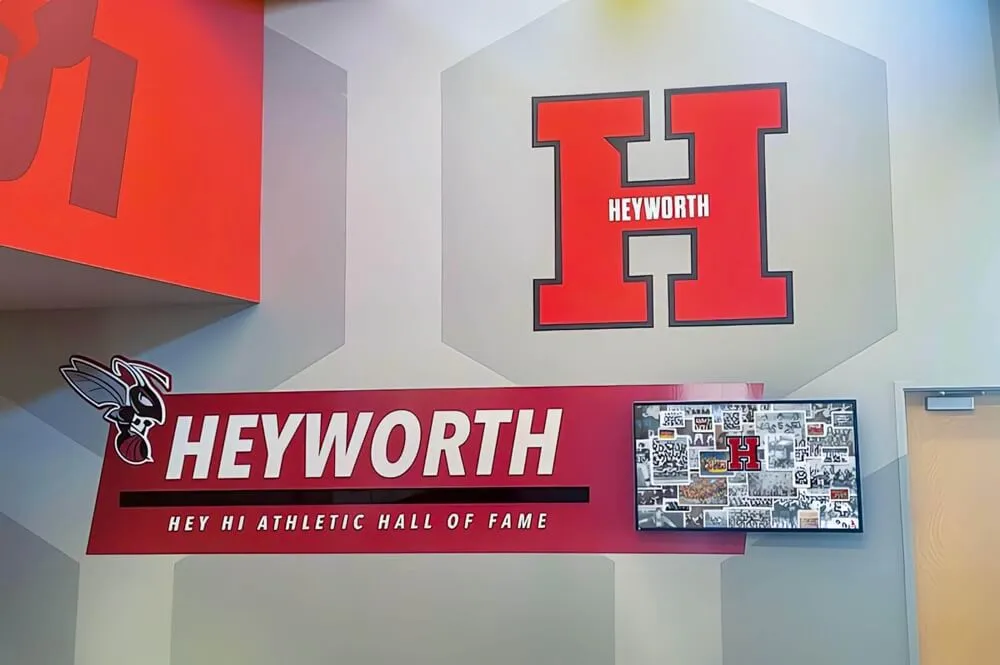
Advantages of Traditional Approaches
Traditional signing walls offer several benefits including tactile permanence that creates lasting physical tributes, no technology requirements avoiding technical complications, aesthetic tradition that complements historic school architecture, and one-time costs without recurring digital subscription fees.
These approaches work particularly well for schools with limited technology budgets or those seeking to maintain traditional aesthetic values in historic buildings.
Limitations of Traditional Displays
However, traditional approaches face several constraints:
Space Limitations: Physical wall space is finite. Schools with multiple signings annually quickly run out of room, forcing difficult choices about which athletes to recognize or how long to maintain displays.
Update Challenges: Adding new signings requires physical production of new plaques or photos, installation logistics, and often professional services—all taking time and creating delays between commitment and recognition.
Limited Information: Space constraints limit how much information can be included. Traditional plaques typically show only basic details like name, sport, and college, missing opportunities to tell fuller stories about athlete journeys.
Maintenance Issues: Physical displays deteriorate over time. Photos fade, plaques tarnish, and materials require replacement, creating ongoing maintenance needs and costs.
Static Presentation: Traditional displays cannot incorporate video highlights, multimedia content, or interactive elements that resonate with today’s digitally-native students.
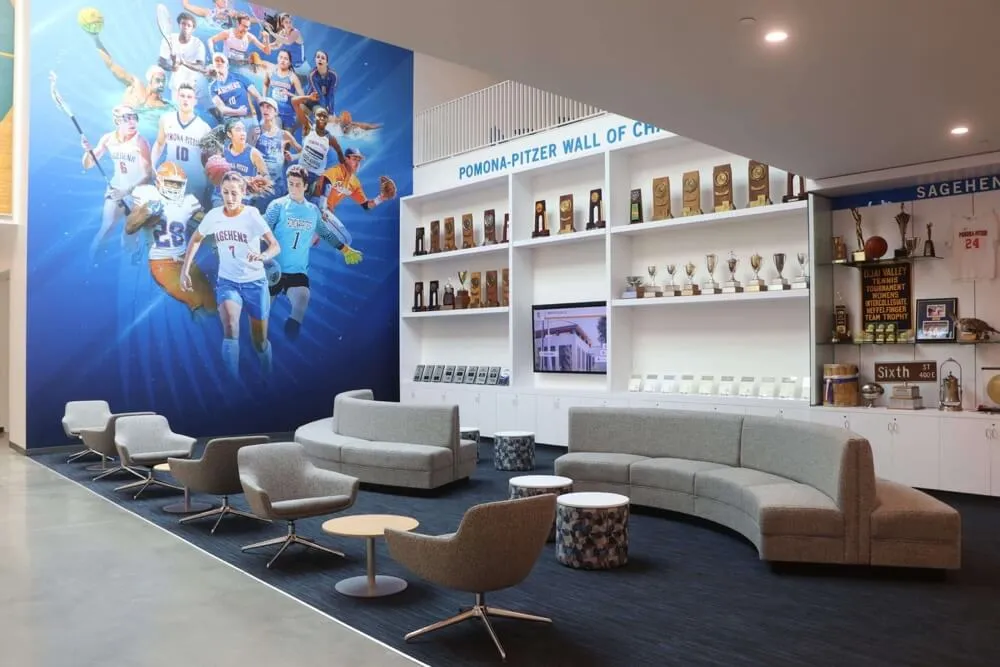
Modern Digital Signing Wall Solutions
Technological advancement has created new possibilities for college signing recognition that address traditional limitations while offering capabilities impossible with physical displays.
Digital Recognition Displays
Interactive touchscreen displays and digital signage systems provide dynamic, updateable platforms for celebrating college signings with unlimited capacity and rich multimedia content.
Touchscreen Kiosks: Standalone interactive displays enable visitors to explore signing information through intuitive touch interfaces. Users can search by athlete name, sport, graduation year, or destination college, accessing detailed profiles impossible with traditional plaques.
Solutions like digital hall of fame displays transform static recognition into engaging experiences where students, parents, and visitors actively explore content rather than passively viewing fixed displays.
Digital Signage Networks: Wall-mounted digital screens display rotating content showcasing recent signings, highlight videos, and athlete profiles. Content updates remotely without requiring physical installation work.
Hybrid Approaches: Many schools implement combination strategies using traditional displays for historic recognition while adding digital systems for current signings. This balances respect for tradition with modern capabilities.
Advantages of Digital Signing Walls
Unlimited Recognition Capacity
Digital platforms accommodate unlimited athlete profiles spanning decades without physical space constraints. Schools can recognize every signing across all sports and years without removing historical content.
Rich Multimedia Integration
Include professional photos, action shots, video highlights, signing day footage, and athlete interviews. Video commitment announcements and highlight reels create emotional connections static displays cannot match.
Real-Time Updates
Add new signings immediately after announcements without waiting for plaque production or physical installation. Update existing profiles with college career achievements as alumni progress.
Intuitive Navigation and Search
Visitors find specific athletes instantly through search functions. Parents attending games can quickly locate their children’s profiles, while prospective families explore the school’s college placement track record.
Extended Reach Beyond Campus
Many interactive systems integrate with web platforms, extending recognition beyond physical displays. Alumni worldwide can explore current signings, and recruits can access information remotely.
Cost-Effective Long-Term
While requiring higher initial investment, digital systems eliminate recurring plaque costs. Most achieve cost neutrality within 5-7 years while providing enhanced capabilities throughout their lifespan.
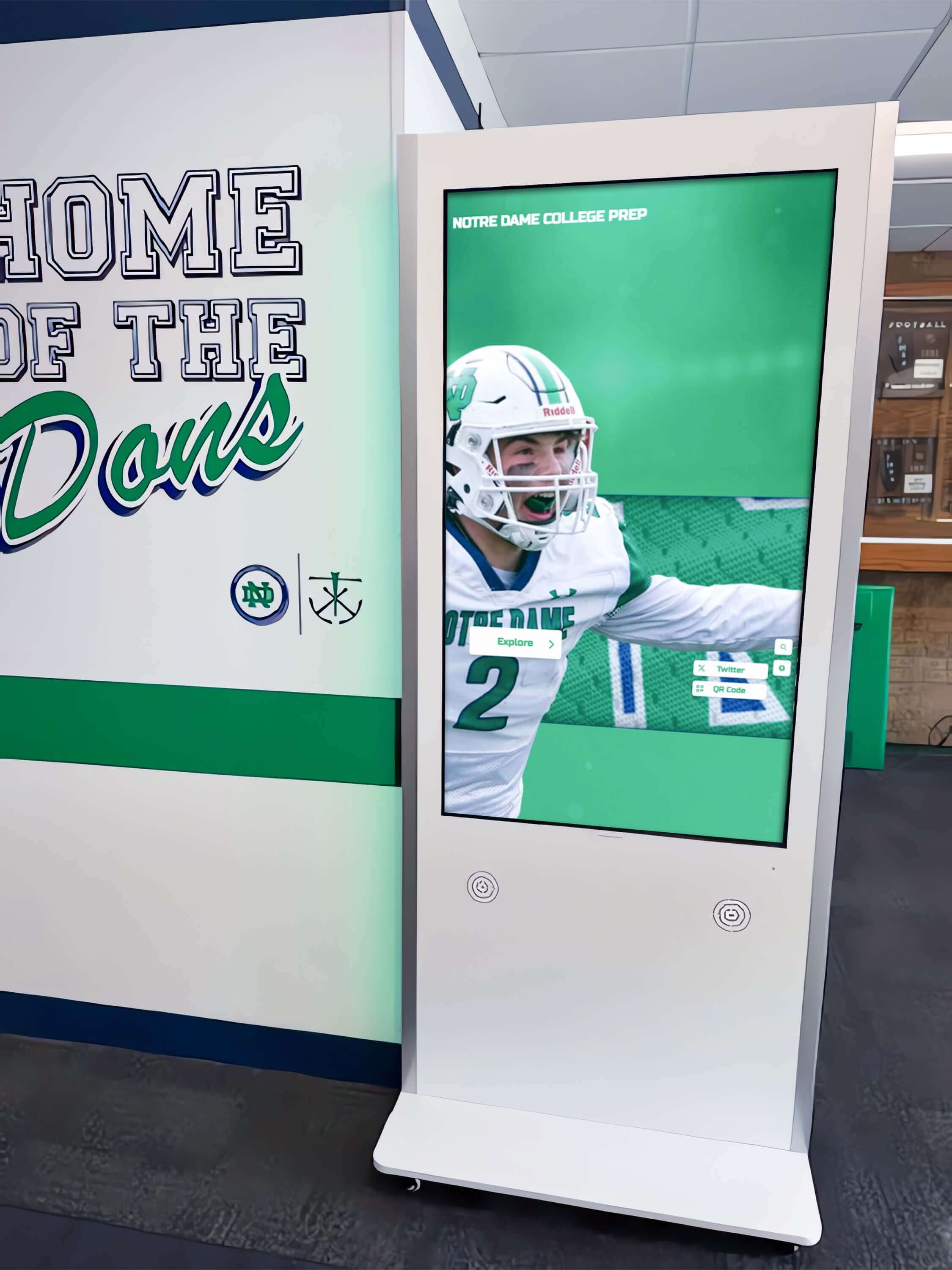
Key Features for Digital Signing Walls
When evaluating digital signing wall solutions, high schools should consider platforms offering:
User-Friendly Content Management: Cloud-based systems enabling easy updates through intuitive interfaces requiring no technical expertise. Staff should be able to add new signings, upload photos, and edit information without IT department involvement.
Mobile Responsiveness: Systems that work seamlessly across devices—from large touchscreen displays to smartphones and tablets. This ensures consistent experiences whether viewing in person or remotely online.
Customizable Design Templates: Branding options reflecting school colors, logos, and aesthetic preferences while maintaining professional presentation quality.
Analytics and Insights: Data tracking which athletes receive most attention, peak usage times, and content engagement patterns. This information informs future content development and demonstrates display value.
Integration Capabilities: Ability to connect with school websites, social media platforms, and existing databases for seamless content distribution across multiple channels.
Programs like Rocket Alumni Solutions specialize in educational recognition, offering purpose-built platforms designed specifically for schools with templates, best practices, and support tailored to high school athletic programs.
Creating Effective College Signing Wall Content
Whether implementing traditional displays or digital systems, the quality and comprehensiveness of content significantly impacts recognition effectiveness and inspirational value.
Essential Information to Include
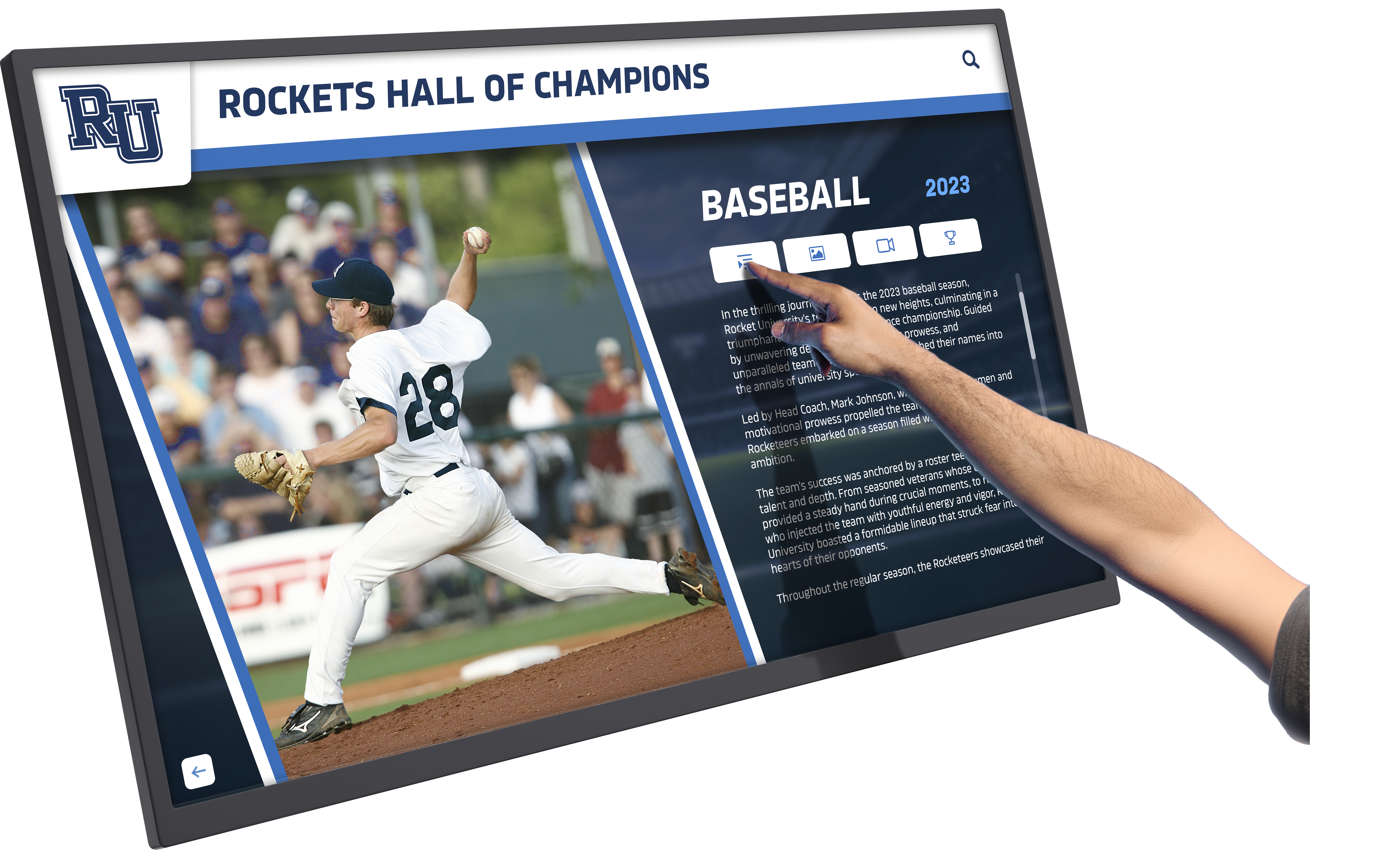
Student-Athlete Profile Elements:
- Full name and graduation year
- Sport(s) signed for
- Position(s) played
- High school career statistics and achievements
- All-conference, all-state, or other honors
- Academic accomplishments and GPA
- Community involvement and leadership roles
College Information:
- University name and location
- Division level (NCAA Division I, II, III, NAIA, NJCAA)
- Athletic conference
- Why the athlete chose this college
- Intended major or academic program
- Athletic scholarship information (when publicly shared)
Visual Assets:
- Professional headshot or team photo
- Action shots from competitions
- Signing ceremony photos with family and coaches
- College logo and team colors
- Video commitment announcement (for digital displays)
- Highlight reels showcasing athletic ability
The more comprehensive the profile information, the more engaging and inspiring the recognition becomes for students, families, and community members.
Writing Compelling Athlete Stories
Beyond basic information, effective signing recognition tells authentic stories about athlete journeys:
Development Narrative: Describe the athlete’s progression from freshman year through commitment—challenges overcome, improvement demonstrated, and dedication required to reach the collegiate level.
Impact and Contribution: Highlight specific contributions to team success, leadership roles, mentorship of younger athletes, and character demonstrated beyond statistics.
Personal Motivation: Include brief quotes from athletes about what drives them, what the opportunity means to them, or advice for younger athletes pursuing similar goals.
Future Aspirations: Share plans for college careers, academic goals, and long-term aspirations showing that athletic commitment integrates with broader life planning.
Signing Day Celebrations and Ceremonies
National Signing Day events provide crucial opportunities to celebrate commitments publicly while gathering content for ongoing recognition throughout the year.
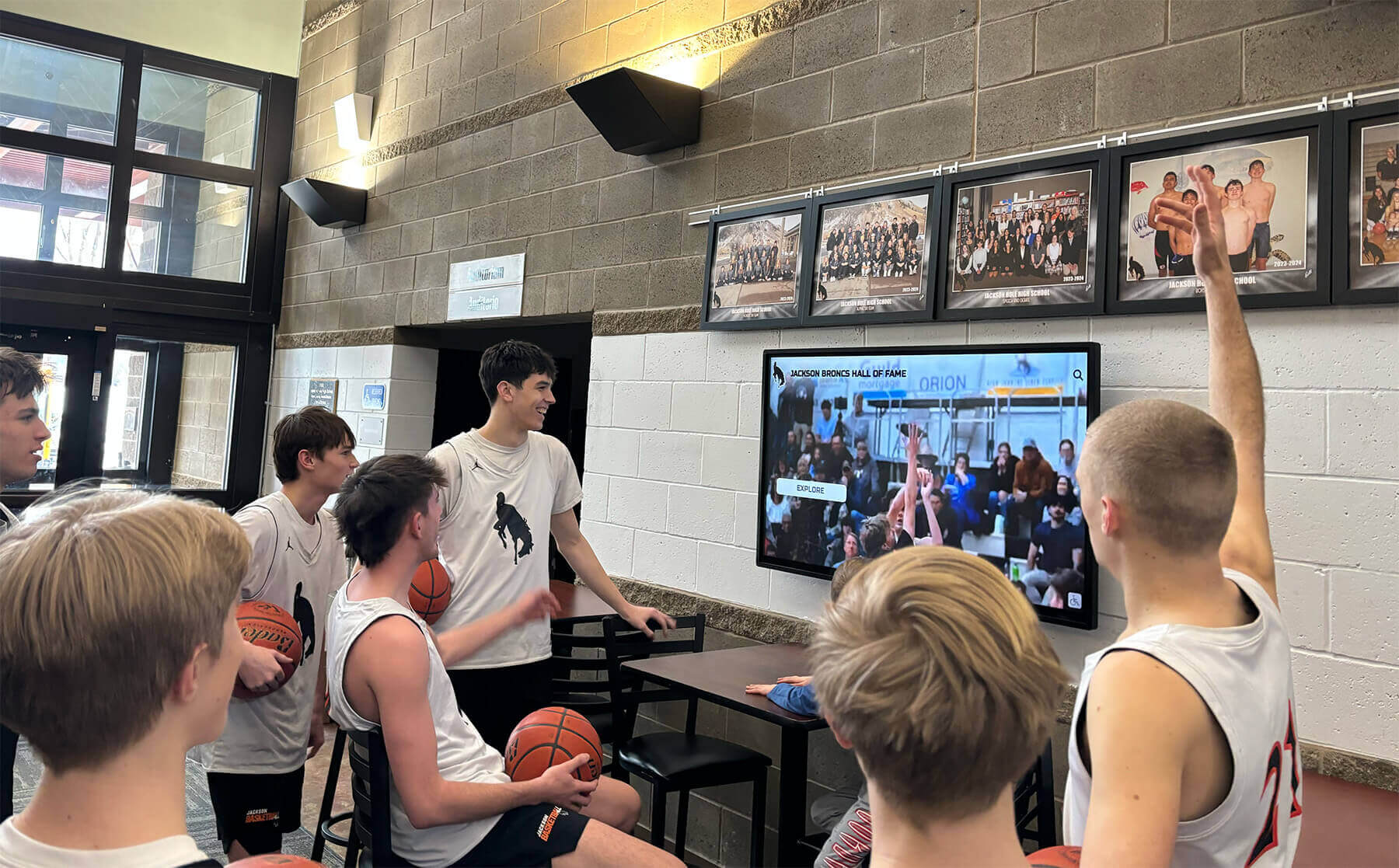
Organizing Effective Signing Ceremonies
According to the NCAA, National Signing Day for most sports falls in November and February, creating natural opportunities for celebration events. However, many schools also hold individual or small-group signings throughout the year as commitments occur.
Traditional Fall Signing Day (November): Early signing period for football and women’s basketball, providing first major celebration opportunity of the academic year.
Spring National Signing Day (February): Final signing period for most other sports, often generating the largest ceremonies with athletes from multiple programs signing together.
Year-Round Recognition: Some schools host individual signings when commitments happen outside major signing periods, ensuring every athlete receives timely celebration.
Ceremony Elements That Create Impact
Professional Setup: Designated signing tables with college pennants, branded gear, and professional backdrops create photo-worthy settings documenting these milestone moments.
Family Involvement: Including parents, siblings, and key supporters in ceremonies recognizes the community effort behind athletic achievement and creates meaningful family memories.
Coach and Administrator Remarks: Brief speeches from athletic directors, principals, and coaches provide context about athlete accomplishments and program pride in these achievements.
Athlete Testimonials: Giving signing athletes opportunities to thank supporters, explain college choices, and share advice for younger athletes creates authentic, memorable moments.
Media Coverage: Inviting local media, live-streaming ceremonies, and coordinating social media coverage extends recognition reach beyond physical attendees.
Content Capture: Professional photography and video documentation from signing day provides rich content for showcasing college commitments throughout the year on signing walls, school websites, and social media platforms.
Integrating with School Traditions
Connecting signing recognition to existing school traditions maximizes visibility and celebration:
Homecoming Recognition: Feature current year signings during homecoming events, create special displays during homecoming week, and facilitate alumni athlete meet-and-greet opportunities.
Senior Night Celebrations: Honor all senior athletes during senior night while providing special recognition for those continuing their careers, ensuring every senior feels valued regardless of college commitment status.
Athletic Award Ceremonies: Include signing recognition in year-end banquets through special categories, video montages, and commemorative items celebrating these achievements alongside other athletic honors.
Strategic Placement and Visibility
Where schools position college signing walls significantly impacts how many people encounter displays and the impressions these encounters create.
High-Traffic Location Selection
Main Entrance Areas: Position signing recognition where visitors first enter buildings. This placement creates immediate positive impressions and establishes athletic achievement visibility before people proceed deeper into facilities.
Athletic Facility Entrances: Lobbies and hallways leading to gymnasiums, locker rooms, or athletic offices represent natural locations where athletes, families, and visitors regularly pass.
Cafeteria and Common Areas: Spaces where students gather daily ensure broad visibility across the student body, not just those involved in athletics.
Gymnasium and Arena Visibility: Displays visible from spectator seating during games and competitions enable ongoing recognition when the athletic community gathers.
For schools implementing interactive campus displays, placement in frequently toured areas provides powerful showcases for prospective families evaluating school choice options.
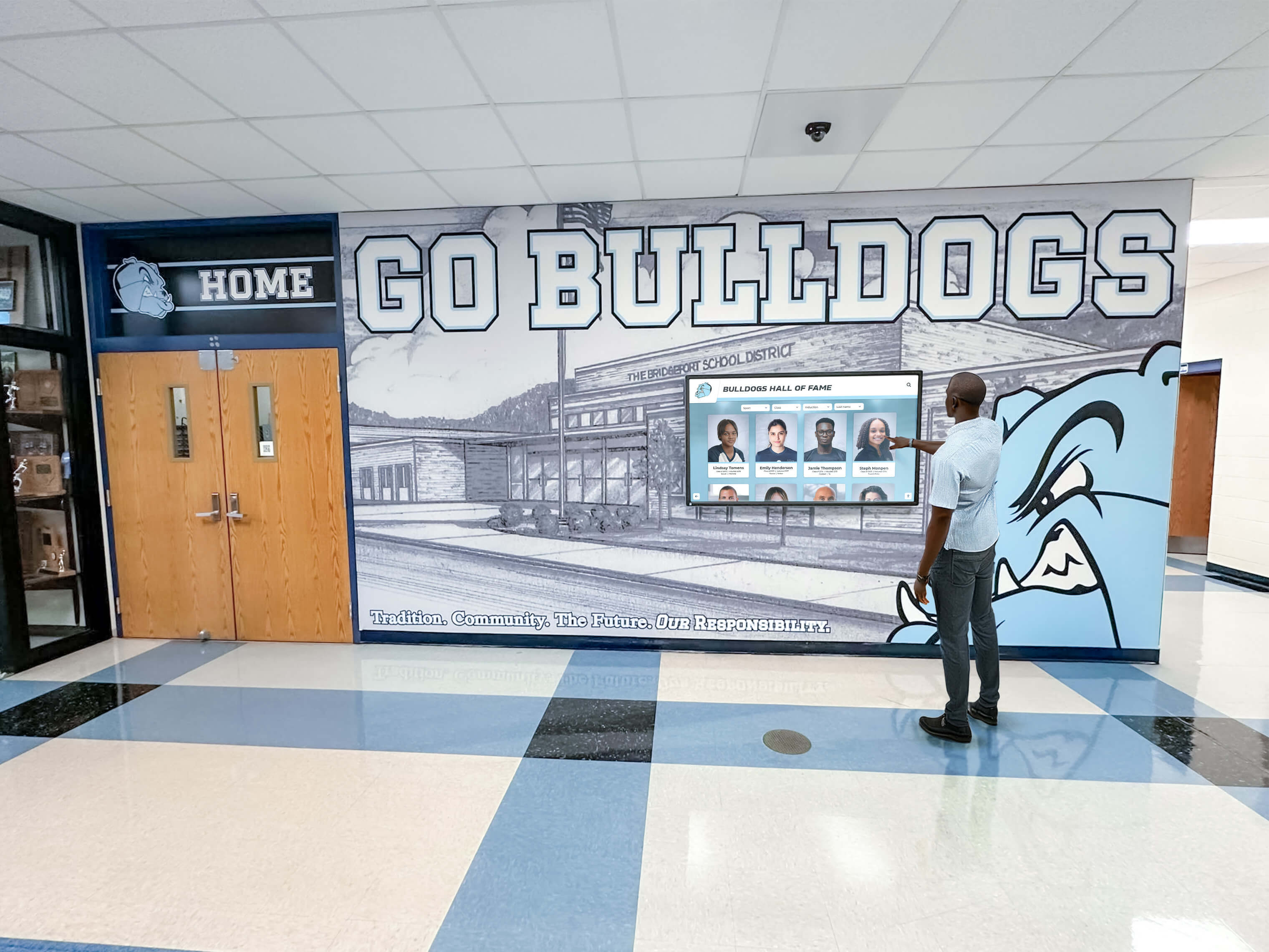
Considerations for Different School Contexts
Large Schools with Many Signings: Programs with 20, 30, or 50+ annual commits require systems capable of handling high volume without overwhelming viewers. Digital displays excel in these contexts through search, filtering, and organized navigation features.
Small Schools with Limited Signings: Schools with only a few annual signings deserve equally impressive recognition through comprehensive, detailed profiles and prominent placement ensuring these significant achievements receive appropriate celebration.
Multi-Sport Recognition Balance: Ensure signing walls provide equitable recognition across all sports—not just high-profile programs like football and basketball. Every college athletic commitment represents extraordinary achievement deserving celebration.
Budget Considerations and Implementation Costs
High schools evaluating signing wall options need realistic budget expectations and understanding of various implementation approaches.
Traditional Display Cost Ranges
Basic Bulletin Board Approach: $200-$500 for materials including frames, mounting supplies, and printing. Annual updates require minimal additional investment.
Professional Plaque Systems: $50-$150 per athlete for custom plaques, plus installation costs. Schools with 15-20 annual signings face $750-$3,000 yearly expenses.
Custom Wall Installations: Comprehensive traditional displays with built-in lighting, custom cabinetry, and professional design range from $5,000-$15,000 for initial installation.
Digital Display Investment
Entry-Level Digital Signage: Basic digital screens with content management start around $2,000-$4,000 per display, suitable for rotating slideshow presentations.
Interactive Touchscreen Systems: Professional touchscreen kiosks with comprehensive software range from $8,000-$20,000 depending on screen size, enclosure quality, and software capabilities.
Comprehensive Recognition Platforms: Full-featured systems combining physical displays, cloud software, mobile access, and ongoing support typically range from $15,000-$35,000 for initial implementation.
Ongoing Costs: Budget $1,000-$3,000 annually for software subscriptions, content management support, and display maintenance.
Funding Strategies
Schools can pursue multiple funding approaches:
Athletic Booster Clubs: Booster organizations often prioritize recognition programs demonstrating program success and inspiring continued excellence.
Sponsorship Opportunities: Local businesses may sponsor signing wall sections in exchange for visibility, particularly businesses owned by alumni or community members.
Capital Campaigns: Larger recognition projects can be incorporated into facility improvement campaigns, especially when tied to athletic facility renovations.
Alumni Donations: Alumni who benefited from athletic programs may be willing to fund recognition systems ensuring current athletes receive similar celebration.
Phased Implementation: Start with basic systems and expand capabilities over time as funding becomes available and value is demonstrated.
Best Practices for Sustainable Recognition Programs
Long-term signing wall success requires systematic planning addressing content management, maintenance, and continuous improvement.
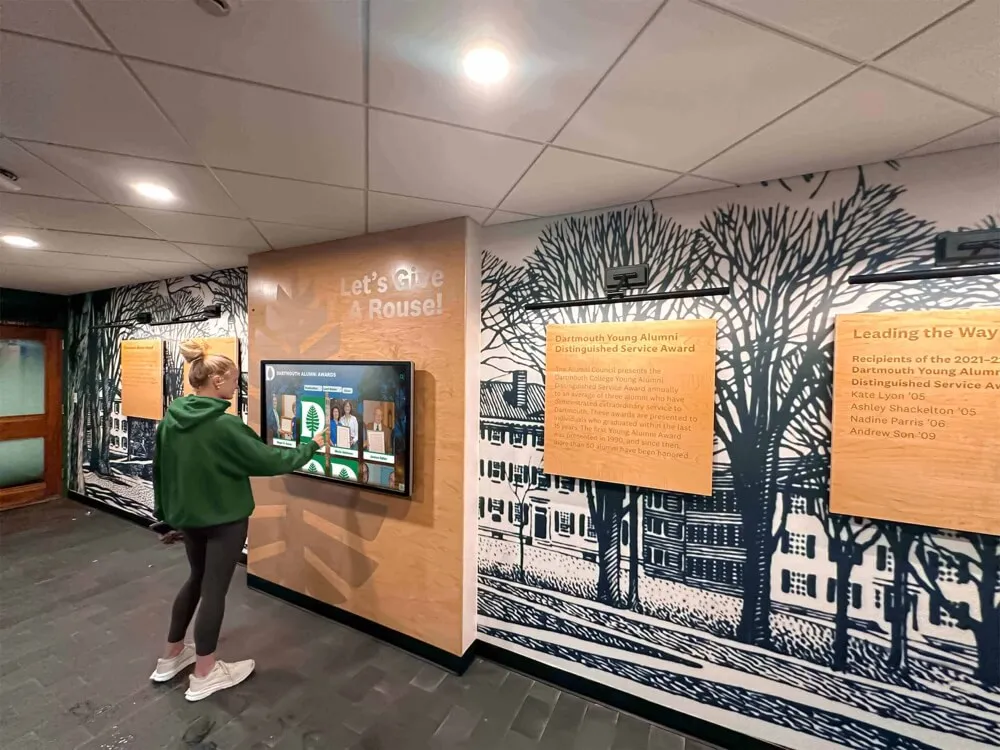
Establishing Administrative Workflows
Clear Responsibility Assignment: Designate specific staff members responsible for different signing wall elements:
- Primary administrator overseeing overall program
- Sport-specific contacts submitting athlete information
- Content coordinator creating profiles and managing updates
- Technical administrator handling display maintenance (for digital systems)
- Photography coordinator capturing signing day and athlete images
Information Collection Processes: Create standardized forms athletes and coaches complete when commitments occur, including all profile elements, photo requirements, and permission forms for media use.
Timeline Standards: Establish expectations for how quickly new signings are added to displays after announcements—ideally within 24-48 hours for digital systems or within 1-2 weeks for traditional displays.
Content Quality Standards
Photography Guidelines: Maintain consistent quality through high-resolution images (minimum 1920 x 1080 pixels for digital displays), professional or high-quality smartphone photos, appropriate backgrounds and lighting, and friendly, professional presentation.
Writing Consistency: Develop style guides ensuring similar tone, length, and structure across all athlete profiles. This creates professional, unified presentation regardless of who writes individual profiles.
Accuracy Verification: Cross-reference all statistics, colleges, and details before publication. Errors in recognition displays can embarrass athletes and damage program credibility.
Privacy and Permission Management
Media Release Policies: Implement clear policies addressing:
- General media release forms during athletic program participation
- Specific permission for signing wall publication
- Right to review content before publication
- Opt-out mechanisms for privacy-concerned families
- Post-graduation policies for profile retention
Sensitive Information Protocols: Be conservative with information like specific scholarship amounts (unless publicly disclosed), financial aid details, home addresses or contact information, and medical history or injury information.
Measuring Impact and Success
Evaluate signing wall effectiveness through both quantitative metrics and qualitative feedback to understand program value and identify improvement opportunities.
Engagement Metrics
For digital recognition systems, track:
- Daily interaction counts and viewing sessions
- Average time spent exploring content
- Most-viewed athlete profiles
- Search queries revealing user interests
- Peak usage times and seasonal patterns
Social Media Reach: Monitor sharing, likes, comments, and engagement when posting signing wall content on social platforms. High engagement indicates content resonates with community audiences.
Community Feedback
Gather input systematically from multiple stakeholder groups:
Athlete and Family Perspectives: Survey signing athletes about recognition experience, profile accuracy, and impact on college transition. Request suggestions for program improvement.
Younger Athlete Input: Assess inspirational impact through conversations with underclassmen about whether signing recognition influences their goals, motivation, and awareness of college athletic opportunities.
Coach Perspectives: Collect coach observations about recognition program impact on recruiting, team culture, and program reputation. Coaches interact daily with prospective athletes and families who view signing displays.
Visitor Comments: Note feedback from campus visitors, prospective families, and community members about signing wall impressions and effectiveness.
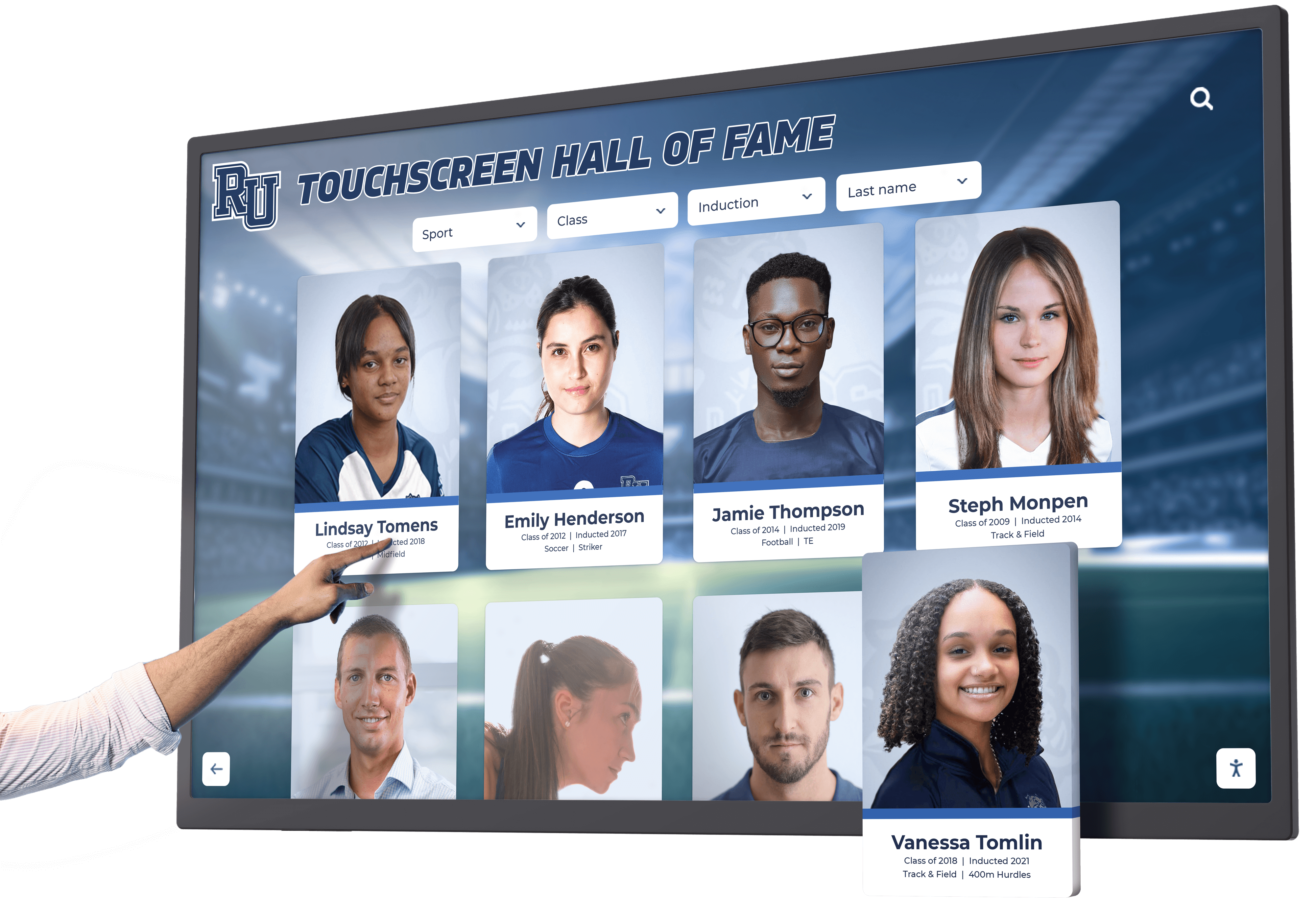
Program Impact Indicators
Beyond direct metrics, observe broader program impacts:
- Changes in youth athlete participation in feeder programs
- Increased interest in athletic programs during school choice decisions
- Enhanced media coverage of athletic program achievements
- Improved alumni engagement and giving to athletic programs
- College coach feedback about program reputation and visibility
Connecting Signing Walls to Broader Recognition Programs
College signing walls work most effectively as components of comprehensive athletic recognition strategies rather than standalone initiatives.
Integration with Hall of Fame Programs
Many schools integrate signing recognition with broader athletic hall of fame programs that celebrate multiple achievement types:
Athletic Hall of Fame: Induct exceptional alumni athletes based on college athletic success, professional careers, or lifetime contributions to school athletics.
Coaching Recognition: Honor coaches who developed successful programs, mentored athletes, or contributed significantly to school athletic culture.
Team Championships: Commemorate championship teams through group photos, rosters, and season highlights alongside individual athlete recognition.
Record Performances: Document school records in each sport, celebrating athletes who achieved extraordinary statistical or competitive milestones.
Connecting to Academic Recognition
Well-rounded recognition programs celebrate achievements beyond athletics:
Academic Excellence: Recognize student-athletes achieving high GPAs, academic honors, or acceptance to selective academic programs.
Scholarship Recognition: Celebrate both athletic and academic scholarships, demonstrating institutional commitment to holistic student development.
Leadership and Service: Honor captains, team leaders, and athletes contributing significantly to school and community through service and character.
This comprehensive approach reinforces that athletic commitment integrates with academic achievement and personal development rather than existing separately.
Supporting Broader School Culture
Effective signing walls contribute to positive school culture by:
- Demonstrating institutional investment in student success
- Creating visible examples of achievement for all students
- Building pride across entire school communities, not just athletic departments
- Attracting ambitious families seeking schools that celebrate excellence
- Creating gathering points where students, staff, and families connect over shared pride
Future Trends in College Signing Recognition
Looking ahead, several emerging trends will shape how schools recognize college athletic commitments.
Enhanced Digital Capabilities
Augmented Reality Features: Future systems may overlay digital content onto physical spaces, enabling smartphone users to access expanded signing information by pointing cameras at traditional displays.
Social Media Integration: Direct connections enabling athletes to update their own profiles with college career achievements, creating dynamic recognition that evolves as alumni progress.
Video Messaging: Athletes may record personalized video messages for younger teammates or prospective students, creating mentorship connections through recognition platforms.
Live Streaming Integration: Automatically incorporating signing ceremony live streams into permanent recognition displays, preserving these milestone moments indefinitely.
Data-Driven Insights
Advanced analytics may enable:
- Tracking which signing profiles inspire most younger athlete engagement
- Correlating signing wall visibility with youth program participation trends
- Identifying which colleges recruit most frequently from specific programs
- Understanding demographic patterns in college athletic placement
Expanded Recognition Scope
Future programs may broaden beyond traditional college athletics to include:
- Club sport participation at colleges
- Athletic training and sports medicine academic programs
- Esports college teams and competitive gaming
- International athletic opportunities abroad
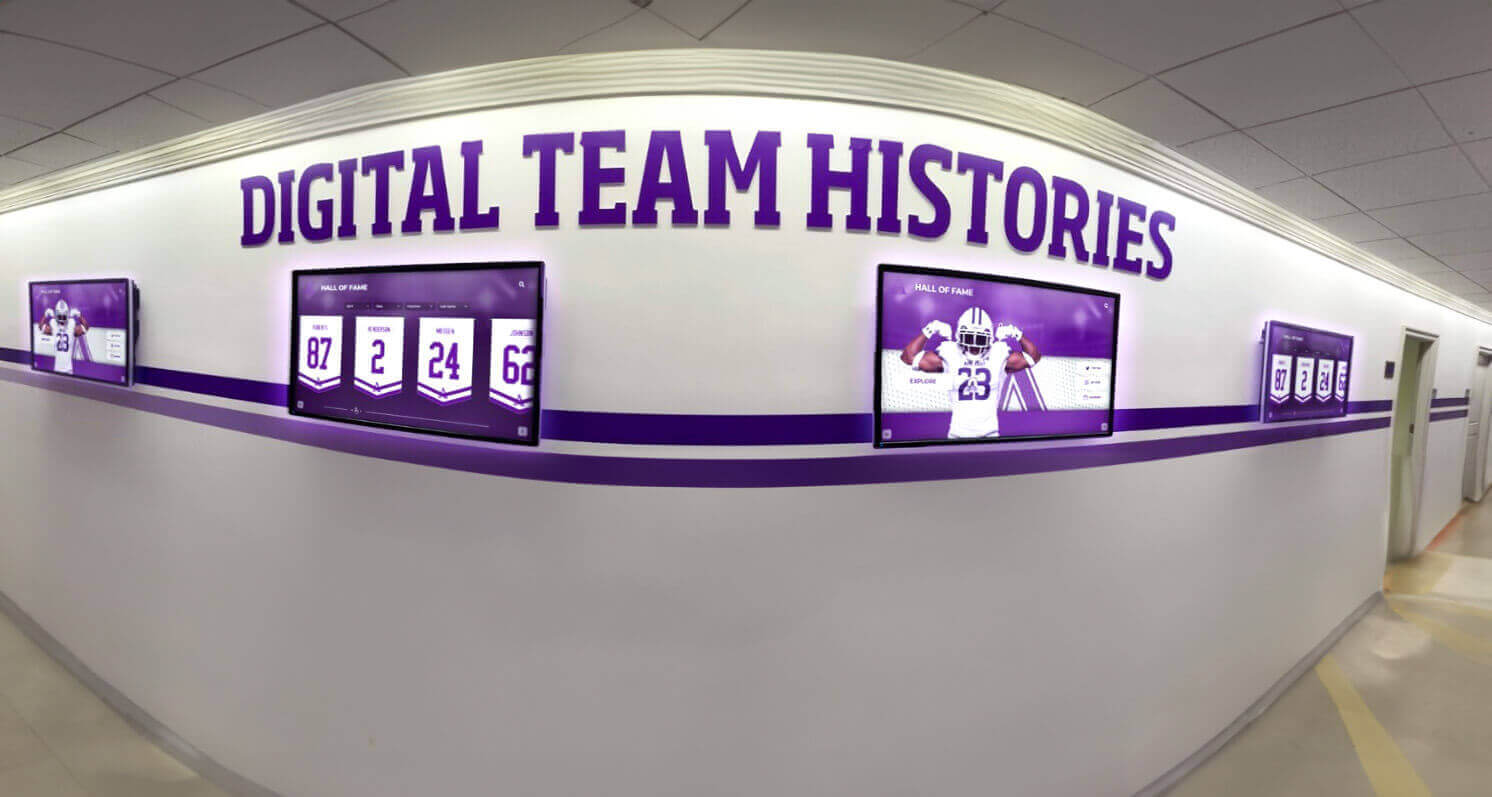
Getting Started: Implementation Roadmap
For high schools ready to implement or upgrade college signing wall programs, follow this strategic roadmap:
Phase 1: Assessment and Planning (2-3 months)
Needs Evaluation: Assess current recognition gaps, typical annual signing numbers, available budget, physical space options, and staff capacity for ongoing management.
Stakeholder Input: Gather input from athletic directors, coaches, administrators, athletes, parents, and booster organizations about priorities and preferences.
Research Options: Explore traditional display contractors, digital display vendors, comprehensive recognition platforms, and examples from peer schools.
Budget Development: Create realistic budget including initial implementation costs, annual operating expenses, and potential funding sources.
Phase 2: Vendor Selection and Design (1-2 months)
Vendor Evaluation: For digital systems, assess providers based on educational experience, platform capabilities, implementation support, ongoing service quality, and total cost of ownership.
Design Customization: Work with selected vendors to customize displays reflecting school branding, colors, logo, and aesthetic preferences while maintaining professional quality.
Content Planning: Develop templates, style guides, information collection forms, and workflow processes ensuring consistent, high-quality content creation.
Phase 3: Implementation and Launch (2-3 months)
Hardware Installation: For digital systems, complete electrical work, network connectivity, display mounting, and enclosure installation. For traditional displays, complete construction and mounting.
Software Configuration: Set up content management systems, import historical signing information if available, train designated staff on platform use, and create initial content library.
Soft Launch: Begin displaying recognition with current content, monitor for technical issues or content needs, gather initial feedback from users, and refine based on early observations.
Official Celebration: Host launch event during signing day, homecoming, or other high-visibility occasion, generate media coverage, communicate availability to community, and celebrate this new recognition capability.
Phase 4: Ongoing Management and Optimization
Regular Content Updates: Add new signings promptly, update profiles with college career achievements, maintain photo and information quality, and refresh featured content regularly.
Community Engagement: Promote signing wall through school communications, encourage athlete and family interaction, share content via social media, and gather ongoing feedback for improvements.
Program Assessment: Review engagement metrics and community feedback, assess impact on program culture and recruitment, identify enhancement opportunities, and plan expansions or upgrades when beneficial.
Conclusion: Celebrating Achievement, Building Excellence
College signing walls represent far more than simple displays listing athlete names and destination schools. When implemented thoughtfully, these recognition programs honor extraordinary individual achievement, inspire younger athletes to pursue their own collegiate dreams, build school pride and positive athletic culture, demonstrate program quality to prospective families and athletes, create lasting connections between schools and successful alumni, and celebrate the dedication, perseverance, and accomplishment that college athletic opportunities represent.
Whether implementing traditional photo boards or comprehensive digital recognition systems, the keys to success include comprehensive content telling complete athlete stories, prominent placement ensuring high visibility, systematic management processes maintaining quality and currency, integration with broader school culture and recognition programs, and genuine celebration of diverse achievements across all sports and division levels.
As you develop or enhance your school’s college signing wall, remember that you’re not simply posting names and colleges—you’re creating inspirational environments where dreams become tangible, excellence receives appropriate celebration, and every student-athlete’s hard work and achievement are honored with the dignity and permanence they deserve.
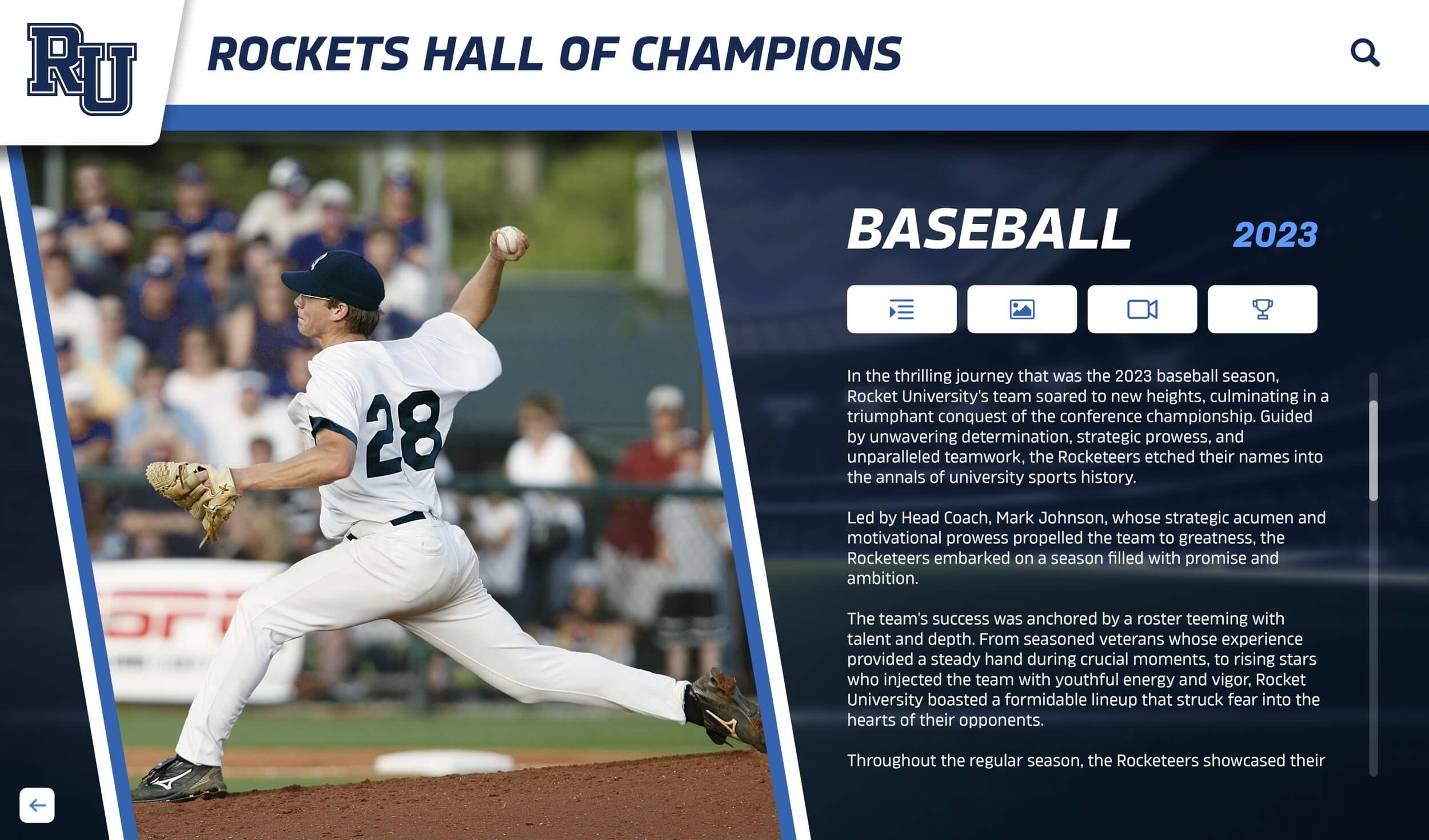
Ready to Transform Your College Signing Recognition?
Explore how Rocket Alumni Solutions can help you create comprehensive signing wall programs that celebrate student-athlete commitments, inspire future athletes, and build lasting athletic traditions. Our digital recognition solutions are designed specifically for high schools, offering intuitive platforms that make it easy to honor every signing athlete with the recognition they deserve.
Visit Rocket Alumni Solutions to discover how digital recognition transforms signing celebrations from temporary bulletin boards into permanent, engaging tributes that evolve with your program. For additional insights on athletic recognition best practices, explore our guides on college coach visits and recruiting displays and student-athlete recognition programs.
Contact us today to discuss your vision for college signing recognition and discover how the right solution can elevate your athletic program while inspiring the next generation of student-athletes.





































